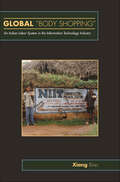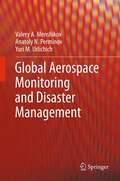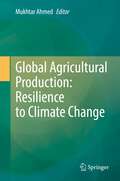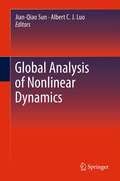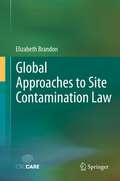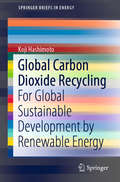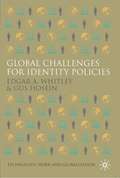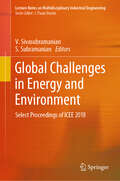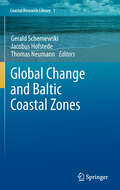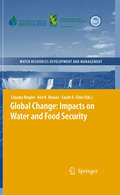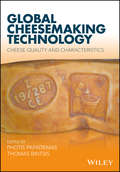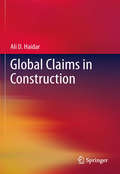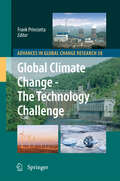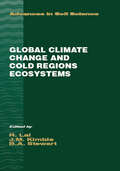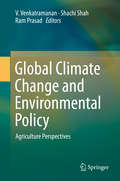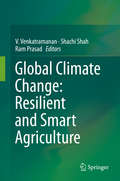- Table View
- List View
Glial Cell Engineering in Neural Regeneration
by Li YaoThis book focuses on current applications of glial cells in neural regeneration, especially in spinal cord repair. It introduces the application of a few types of glial cells including oligodendrocyte, astrocyte, Schwann cells, and stem cell derived glial cells in neural regeneration. The latest glial cell research with biomaterials, gene modification, and electrical signals is also summarized. This is an ideal book for undergraduate and research students in tissue engineering, neurobiology, and regenerative medicine as well as researchers in the field.
Glide-Symmetric Z2 Magnetic Topological Crystalline Insulators (Springer Theses)
by Heejae KimThis book presents a comprehensive theory on glide-symmetric topological crystalline insulators. Beginning with developing a theory of topological phase transitions between a topological and trivial phase, it derives a formula for topological invariance in a glide-symmetric topological phase when inversion symmetry is added into a system. It also shows that the addition of inversion symmetry drastically simplifies the formula, providing insights into this topological phase, and proposes potential implementations. Lastly, based on the above results, the author establishes a way to design topological photonic crystals. Allowing readers to gain a comprehensive understanding of the glide-symmetric topological crystalline insulators, the book offers a way to produce such a topological phase in various physical systems, such as electronic and photonic systems, in the future.
Glitter Everywhere!: Where it Came From, Where It's Found & Where It's Going
by Chris BartonFans of How It&’s Made will love this fresh, irreverent look at the science and story behind glitter.If you love glitter, this book is for you. If you hate glitter, this book is also for you.Everyone seems to have an opinion about glitter. But how much do you know about the tiny, shiny confetti? What makes glitter glitter? Why does it stick to everything? Who invented it? How is it made? Is glitter bad for the environment?Chris Barton&’s informative wit and Chaaya Prabhat's vibrant art make Glitter Everywhere sparkle as it covers the good, the bad, and shiny of all things glitter.
Global "Body Shopping": An Indian Labor System in the Information Technology Industry (In-Formation)
by Xiang BiaoHow can America's information technology (IT) industry predict serious labor shortages while at the same time laying off tens of thousands of employees annually? The answer is the industry's flexible labor management system--a flexibility widely regarded as the modus operandi of global capitalism today. Global "Body Shopping" explores how flexibility and uncertainty in the IT labor market are constructed and sustained through concrete human actions. Drawing on in-depth field research in southern India and in Australia, and folding an ethnography into a political economy examination, Xiang Biao offers a richly detailed analysis of the India-based global labor management practice known as "body shopping." In this practice, a group of consultants--body shops--in different countries works together to recruit IT workers. Body shops then farm out workers to clients as project-based labor; and upon a project's completion they either place the workers with a different client or "bench" them to await the next placement. Thus, labor is managed globally to serve volatile capital movement. Underpinning this practice are unequal socioeconomic relations on multiple levels. While wealth in the New Economy is created in an increasingly abstract manner, everyday realities--stock markets in New York, benched IT workers in Sydney, dowries in Hyderabad, and women and children in Indian villages--sustain this flexibility.
Global Advances in Engineering Education (Industrial and Systems Engineering Series)
by Waldemar Karwowski J. P. Mohsen Mohamed Y. Ismail Hamid R. ParsaeiThe engineering profession is at a critical juncture that requires reforming engineering education. The supply of engineers is declining whereas the nature of the demand is changing. Formulating a response to these challenges demands the adoption of new and innovative tools and methods for promoting the expansion of the community while supporting these evolving requirements. Initiatives to entice and retain students are being employed to support growth objectives. Modern technologies are reshaping reform efforts. This book discusses the state of affairs in the field of engineering education and presents practical steps for addressing the challenges in order to march toward a brighter future. Features Covers the latest state of engineering education in the North America, Europe, Middle East, North Africa, and Far East Asia Discusses advances in science, technology, engineering, and mathematics and community engagement Outlines applications of digital technologies to enhance learning Provides advances in remote and online instructions for engineering education Presents discussions on innovation, leadership, and ethics
Global Advances in Selenium Research from Theory to Application: Proceedings of the 4th International Conference on Selenium in the Environment and Human Health 2015
by Zhi-Qing Lin Gary S. Bañuelos Milton Ferreira de Moraes Luiz Roberto G. Guilherme André Rodrigues dos ReisThe 4th International Conference on Selenium in the Environment and Human Health was held 18-21 October 2015 in S�Paulo, Brazil. This conference provided an effective scientific communication platform for researchers in different disciplines worldwide to elucidate and better understand those complex roles of Se as both essential nutrient and enviro
Global Aeronautical Distress and Safety Systems (GADSS): Theory and Applications
by Stojče Dimov IlčevThis book presents the principal structure, networks and applications of the Global Aeronautical Distress and Safety System (GADSS) for enhanced airborne Communication, Navigation and Surveillance (CNS). It shows how their implementation works to ensure better security in flight and on the airports surface; improved aircraft tracking and determination in real space and time; and enhanced distress alerting, safety; and Search and Rescue (SAR) system for missing, hijacked and landed aircraft at sea or on the ground. Main topics of this book are as follows: an overview of radio and satellite systems with retrospective to aeronautical safety; security and distress systems; space segment with all aspects regarding satellite orbits and infrastructures; transmission segment of radio and satellite systems; ground segment of radio and earth ground stations; airborne radio and satellite antenna systems and propagation; aeronautical VHF and HF Radio CNS systems and networks; Inmarsat, Iridium and Cospas-Sasrast aeronautical satellite CNS systems and networks; Aeronautical Global Satellite Augmentation System (GSAS) and networks; Digital Video Broadcasting - Return Channel via Satellite (DVB-RCS) standards and Aeronautical Stratospheric Platform Systems (SPS) and networks.
Global Aerospace Monitoring and Disaster Management
by Anatoly N. Perminov Valery A. Menshikov Yuri M. UrlichichIn this book, space systems are situated in the global processes of the 21st century's information society and the role that space information systems could play in risk management is determined; methods of detecting and forecasting of both natural disasters and technogenic catastrophes and existing global and regional monitoring systems are described; and the IGMASS is introduced with its architecture and design concept and social and economic aspects and estimates of its creation, development, and utilization. Finally, results of the international symposium held in Limassol, Cyprus, in November 2009 in preparation of the IGMASS project's submission to the United Nations are discussed.
Global Agricultural Production: Resilience to Climate Change
by Mukhtar AhmedThis book covers all aspects related to climate change and agriculture. The book discusses Global Climate Models (GCMs), Coupled Model Intercomparison Project (CMIP) and application of strategic management tool that includes RCP (Representative concentration Pathway), SSP (Shared Socio-economic Pathways) and SPA (Shared climate Policy Assumptions). The book provides information on how climate change, agricultural productivity and food security are interlinked. The impacts of climate change on food security are studied through different climatic drivers e.g., ENSO (El Niño–Southern Oscillation) and SOI (Southern Oscillation Index). These drivers are responsible for the climatic extreme events hence early prediction of these drivers could help to design appropriate adaptive measures for the agriculture sector and could be considered as early warning tools for risk management. Similarly, climate change and process-based soil modeling as well as the role of soil microbes and climate smart agriculture are discussed in this book. Climate change impacts on legume crop production and adaptation strategies are presented, with details about cereal crop modeling, perspectives of Camelina sativa as well as low input biofuel and oilseed crop, greenhouse gases (GHGs) emissions and mitigation strategies.
Global Analysis of Nonlinear Dynamics
by Albert C. Luo Jian-Qiao SunGlobal Analysis of Nonlinear Dynamics collects chapters on recent developments in global analysis of non-linear dynamical systems with a particular emphasis on cell mapping methods developed by Professor C.S. Hsu of the University of California, Berkeley. This collection of contributions prepared by a diverse group of internationally recognized researchers is intended to stimulate interests in global analysis of complex and high-dimensional nonlinear dynamical systems, whose global properties are largely unexplored at this time.
Global Approaches to Site Contamination Law
by Elizabeth BrandonThe book describes the complex and variable laws addressing site contamination, reviewing existing international, regional and national law of relevance to site contamination. It also offers detailed case studies of national approaches to the issue, and goes on to explore avenues for promoting the development of comprehensive domestic laws on site contamination, with a focus on the role of international law and actors. A detailed discussion analyzes such variations as a binding international legal instrument, a non-binding instrument, and a model framework for site contamination management. The text includes recommendations regarding the key elements needed for regulating site contamination at the national level. The author also offers an appropriate and feasible timetable for international action to promote better national law and policy regarding contaminated sites.
Global Blue Economy: Analysis, Developments, and Challenges (Applied Ecology and Environmental Management)
by Nazrul Islam Steven M. BartellA global blue economy is an economic arena that depends on the benefits and values realized from the coastal and marine environments. This book explains the "sustainable blue economy" as a marine-based economy that provides social and economic benefits for current and future generations. It restores, protects, and maintains the diversity, productivity, and resilience of marine ecosystems, and is based on clean technologies, renewable energy, and circular material flows.
Global Carbon Dioxide Recycling: For Global Sustainable Development by Renewable Energy (SpringerBriefs in Energy)
by Koji HashimotoThis brief describes the current critical situation of global warming and shows its solution by renewable energy use. The author has long studied the development of new materials with chemical functions and is renowned as the first advocate of power-to-gas. He established the technology to convert renewable energy to synthesized natural gas, methane by electrolytic hydrogen generation using surplus electricity from renewable energy, and subsequent methanation of carbon dioxide by reaction with hydrogen.In the first part of this brief, data on global warming and energy consumption are shown and analyzed from the author’s keen point of view. The second part introduces the author’s research results on key materials for global carbon dioxide recycling and constructed pilot plants based on them. Finally, an evidence-based solution to maintain sustainable development by using only renewable energy is described as a future prospect.This book is useful not only for researchers and students studying chemical engineering, materials, or energy, but also for general citizens who are interested in the global environment.
Global Challenges for Identity Policies
by Edgar A. WhitleyThe goals of this book are to provide a comprehensive review of identity policies as they are being implemented in various countries around the world, to consider the key arenas where identity policies are developed and to provide intellectual coherence for making sense of these various activities.
Global Challenges in Energy and Environment: Select Proceedings of ICEE 2018 (Lecture Notes on Multidisciplinary Industrial Engineering)
by S. Subramanian V. SivasubramanianThis book comprises select proceedings of the International Conference on Energy and Environment - Global Challenges (ICEE 2018). The book focuses on applications of green technologies in chemical and biochemical engineering, wastewater treatment, energy and environmental sustainability. It covers current environmental issues such as air pollution and control, solid waste management and wastewater treatment, and suggests potential solutions to tackle them. The contents of this book will be useful to students and researchers working in the field of energy and environmental engineering.
Global Change and Baltic Coastal Zones
by Thomas Neumann Gerald Schernewski Jacobus HofstedeClimate change and ongoing transformation processes in economy and agriculture will have strong and multiple impacts in the Baltic region. In particular coastal zones face increasing hazards, e.g. due to sea level rise or changes in riverine nutrient loads and eutrophication. These changes also offer a wide range of new opportunities in the Baltic Region. Adaptation measures are needed but require a thorough and spatially differentiated understanding of underlying ecological, economic and social processes. Sixteen contributions by authors from eight countries give a comprehensive overview of these changes, their consequences and practical challenges with focus on coastal zones. Besides risks, the chances and opportunities of changes for the region are addressed and adaptation examples and strategies are given. The practitioners' perspective and their demands are integrated in the various contributions.
Global Change: Impacts on Water and food Security
by Asit K. Biswas Sarah Cline Claudia RinglerThis volume examines the various drivers of global change, including climate change, and the use of agricultural knowledge, science, and technology, as well as the outcomes of global change processes, including impacts on water quality and human well-being. Several authors examine potential policy and institutional solutions afforded by globalization to the challenges ahead, particularly the role of trade policy. Financing water development in a more globalized world and adapting to global warming are also examined.
Global Cheesemaking Technology: Cheese Quality And Characteristics
by Photis Papademas Thomas BintsisGlobal Cheesemaking Technology: Cheese Quality and Characteristics reviews cheesemaking practices, and describes cheeses and the processes from which they are manufactured. In addition, the book examines new areas to stimulate further research in addition to the already established knowledge on the scientific principles on cheesemaking. Part I provides an account on the history of cheese, factors influencing the physicochemical properties, flavour development and sensory characteristics, microbial ecology and cheese safety, traceability and authentication of cheeses with protected labels, and traditional wooden equipment used for cheesemaking, while an overview of the cheesemaking process is also presented. Part II describes 100 global cheeses from 17 countries, divided into 13 categories. The cheeses described are well-known types produced in large quantities worldwide, together with some important locally produced, in order to stimulate scientific interest in these cheese varieties. Each category is presented in a separate chapter with relevant research on each cheese and extensive referencing to facilitate further reading.
Global Chemical Kinetics of Fossil Fuels
by Alan K. BurnhamThis book covers the origin and chemical structure of sedimentary organic matter, how that structure relates to appropriate chemical reaction models, how to obtain reaction data uncontaminated by heat and mass transfer, and how to convert that data into global kinetic models that extrapolate over wide temperature ranges. It also shows applications for in-situ and above-ground processing of oil shale, coal and other heavy fossil fuels. It is essential reading for anyone who wants to develop and apply reliable chemical kinetic models for natural petroleum formation and fossil fuel processing and is designed for course use in petroleum systems modelling. Problem sets, examples and case studies are included to aid in teaching and learning. It presents original work and contains an extensive reanalysis of data from the literature.
Global Claims in Construction
by Ali HaidarIn recent years, a number of global claims have failed because they were presented without any systematic analysis, justification or proper calculation of losses. Hence, Global Claims in Construction highlights these issues as well as the importance of understanding causation, factual necessity and the courts' attitude and approach to global claims. Global Claims in Construction addresses the principles of global claims and their calculation methodologies in detail through extensive references to literature, case law and a real world case study. It aims to be a valuable resource for professionals working in the construction industry, as well as students in construction and engineering.
Global Climate Change - The Technology Challenge
by Frank PrinciottaIn order to avoid the potentially catastrophic impacts of global warming, the current 3% CO2 global emission growth rate must be transformed to a 1 to 3% declining rate, as soon as possible. This will require a rapid and radical transformation of the world's energy production and end use systems. The current generation of energy technologies are not capable of achieving the level of mitigation required. Next generations of renewable, low carbon generation and end use technologies will be needed. This book quantifies the mitigation challenge. It then considers the status of key technologies needed to protect the planet from serious climate change impact. Current and emerging technologies are characterized for their mitigation potential, status of development and potential environmental impacts. Power generation, mobile sources, industrial and building sectors are evaluated in detail. The importance and unique challenges for rapidly developing countries, such as China and India are discussed. Current global research and development efforts for key technologies are discussed. It is concluded that it will be necessary to substantially upgrade and accelerate the current worldwide RDD&D effort on both emerging energy technologies and those enabling technologies needed to improve mitigation effectiveness and economics. It will also be necessary to carefully evaluate the potential environmental characteristics of next generation technologies to avoid unacceptable health and ecological impacts. Finally, given the monumental technological challenge associated with transforming the world's energy system, geoengineering options are evaluated, since if successfully deployed, they have the potential to allow more time for the necessary energy system transformation. 'This book on Climate Change not only gives a clear picture of the problem but suggests many of the pitfalls in solving it and recommends strongly, a research program to fill the gaps in our knowledge. It is a most useful reference book for all aspects of the problem.' William D. Ruckelshaus, Madrona Venture Group/Evergreen Venture
Global Climate Change and Cold Regions Ecosystems
by B. A. Stewart R. Lal J. M. KimbleGlobal Climate Change and Cold Regions Ecosystems provides information on soil processes and the carbon cycle in cold ecoregions as well as the soil carbon pool and its fluxes in the soils of cold ecoregions. Filling a void in this area of soil science, this resource explains soil processes influencing C dynamics under natural and disturbed ecosyst
Global Climate Change and Environmental Policy: Agriculture Perspectives
by Ram Prasad Shachi Shah V. VenkatramananGlobal climate change threatens human existence through its potential impact on agriculture and the environment. Agriculture is climate-sensitive, and climate variability and climate change have net negative impact on it. Additionally, the agricultural landscape is affected by monoculture and agro-biodiversity loss, soil fertility depletion and soil loss, competition from biofuel production, crop yield plateaus and invasive species. Nevertheless, the global agricultural production system has to meet the food demands from the growing human population, which is set to exceed 10 billion by 2050. This book discusses the impacts of climate change on agriculture, animal husbandry and rural livelihoods. Further, since agriculture, forestry and other land-use sectors contribute about 10–12 gigatonnes of CO2-equivalent per year, it argues that agricultural policy must dovetail adaptation and mitigation strategies to reduce greenhouse gases emissions. This calls for a reformative and disruptive agricultural strategy like climate-smart agriculture, which can operate at all spatio-temporal scales with few modifications. The book also redefines sustainable agriculture through the lens of climate-smart agriculture in the context of the sustainability of Earth's life- support system and inter- and intra-generational equity. The climate-smart agriculture approach is gaining currency thanks to its inherent positive potential, and its goal to establish an agricultural system which includes "climate-smart food systems", "climate-proof farms", and "climate-smart soils". Climate-smart agriculture provides a pathway to achieve sustainable development goals which focus on poverty reduction, food security, and environmental health.
Global Climate Change and Tropical Ecosystems
by R. Lal, J.M. Kimble and B.A. StewartTropical ecosystems - the regions between the tropics of Cancer and Capricorn - play an important role in global processes, economic issues, and political concerns. In their natural state, tropical ecosystems support a large quantity of above- and below-ground biomass, and constitute a major part of the terrestrial carbon pool. Conversion of the natural ecosystem to agriculture and forestry ecosystems disturbs this ecological balance. Global Climate Change and Tropical Ecosystems presents data on carbon pool fluxes from case studies in 12 countries in tropical regions. The chapters cover:Characteristics of tropical ecosystemsSoil and biotic carbon poolsImpacts of land use and soil managementSlash-and-burn practicesCrop residue and fertility managementThis volume adds to the understanding of pedospheric processes in tropical ecosystems and how to better use soils as a sink for carbon dioxide and other greenhouse gases. With Global Climate Change and Tropical Ecosystems you will understand the link between soil productivity, environmental quality and the global carbon cycle, not only in these ecologically sensitive regions but worldwide.
Global Climate Change: Resilient and Smart Agriculture
by Ram Prasad Shachi Shah V. VenkatramananThis book provides essential insights into methods and practices of ‘Climate-smart Agriculture,’ which is driven by the principles of climate resilience and smart resource use in agricultural production. Climate-smart agriculture is a key policy instrument for achieving poverty eradication and a hunger-free world, as well as mitigating the effects of climate change. This book discusses in detail climate-smart agricultural technologies and practices that can reduce the vulnerability of agricultural systems, improve the livelihoods of farmers and other stakeholders, and reduce the greenhouse gas emissions from crop production and livestock husbandry. The agriculture, forestry and other land use (AFOLU) sector produces roughly 10–12 gigatons of CO2-equivalent per year; therefore, sustainable practices for agriculture and related land use hold immense potential to mitigate climate change. The potential impacts of climate variability and climate change on agriculture are extensively documented and articulated, especially with regard to global and national environmental agendas that call for innovation, transformation and climate-resilient advances in agriculture. As the book demonstrates, climate-smart agriculture offers an excellent tool for boosting agricultural output to feed the growing global population; for reducing greenhouse gases emissions from agriculture and other land use; and for protecting agricultural production systems from the impending dangers of climate change.



